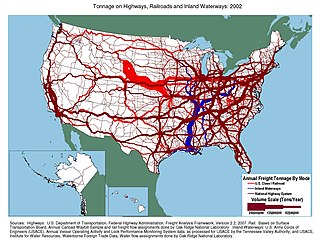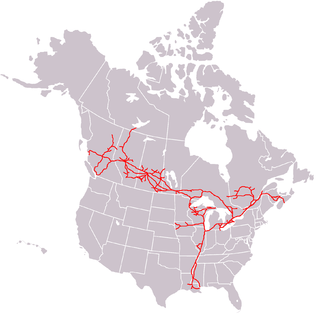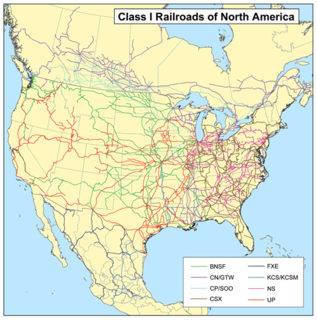
In rail transport, a train is a series of connected vehicles that run along a railway track and transport people or freight. The word train comes from the Old French trahiner, derived from the Latin trahere meaning "to pull, to draw". Trains are typically pulled or pushed by locomotives, though some are self-propelled, such as multiple units. Passengers and cargo are carried in railroad cars, also known as wagons. Trains are designed to a certain gauge, or distance between rails. Most trains operate on steel tracks with steel wheels, the low friction of which makes them more efficient than other forms of transport.

Transportation in the United States is facilitated by road, air, rail, and waterways. The vast majority of passenger travel occurs by automobile for shorter distances, and airplane for longer distances. In descending order, most cargoes travel by railroad, truck, pipeline, or boat; air shipping is typically used only for perishables and premium express shipments. Transportation is the largest source of greenhouse gas emissions by the United States.

The Boston transportation system includes roadway, subway, regional rail, air, and sea options for passenger and freight transit in Boston, Massachusetts. The Massachusetts Port Authority (Massport) operates the Port of Boston, which includes a container shipping facility in South Boston, and Logan International Airport, in East Boston. The Massachusetts Bay Transportation Authority (MBTA) operates bus, subway, short-distance rail, and water ferry passenger services throughout the city and region. Amtrak operates passenger rail service to and from major northeastern cities. A major bus terminal at South Station is served by varied intercity bus companies. The city is bisected by major highways I-90 and I-93, the intersection of which has undergone a major renovation, nicknamed the Big Dig.

Light rail transit (LRT) is a form of passenger urban rail transit characterized by a combination of tram and metro features. While its rolling stock is more similar to a traditional tram, it operates at a higher capacity and speed, and often on an exclusive right-of-way. In many cities, light rail transit systems more closely resemble, and are therefore indistinguishable from, traditional underground or at-grade subways and heavy-rail metros.

The National Railroad Passenger Corporation, doing business as Amtrak, is a passenger railroad service that provides medium and long-distance inter-city rail service in the contiguous United States and to nine cities in Canada. Amtrak is a blend of the words America and trak, the latter itself a sensational spelling of track.

The Canadian National Railway Company is a Canadian Class I freight railway headquartered in Montreal, Quebec, which serves Canada and the Midwestern and Southern United States.

The Staten Island Railway (SIR) is a rapid transit line in the New York City borough of Staten Island. It is owned by the Staten Island Rapid Transit Operating Authority (SIRTOA), a subsidiary of the Metropolitan Transportation Authority, and operated by the New York City Transit Authority Department of Subways. SIR operates 24 hours a day, seven days a week, providing local service between St. George and Tottenville, along the east side of the island. There is currently only one line on the island, and there is no direct rail link between the SIR and the New York City Subway system, but SIR riders do receive a free transfer to New York City Transit bus and subway lines, and the line is included on official New York City Subway maps. Commuters on the railway typically use the Staten Island Ferry to reach Manhattan; the line is accessible from within the Ferry Terminal, and most of its trains connect with the ferry.

In the United States, railroad carriers are designated as Class I, II, or III, according to annual revenue criteria originally set by the Surface Transportation Board in 1992. With annual adjustments for inflation, the 2019 thresholds were US$504,803,294 for Class I carriers and US$40,384,263 for Class II carriers.

Wooden railroads, called wagonways, were built in the United States starting from the 1720s. A railroad was reportedly used in the construction of the French fortress at Louisburg, Nova Scotia, in New France in 1720. Between 1762 and 1764, at the close of the French and Indian War (1756–1763), a gravity railroad is built by British military engineers up the steep riverside terrain near the Niagara River waterfall's escarpment at the Niagara Portage in Lewiston, New York.

The United States Railroad Administration (USRA) was the name of the nationalized railroad system of the United States between December 28, 1917, and March 1, 1920. It was the largest American experiment with nationalization, and was undertaken against a background of war emergency following American entry into World War I. During its brief existence, the USRA made major investments in the United States railroad system, and introduced standardized locomotive and railroad car classes, known as USRA standard. After the end of World War I, while some in the United States advocated for continuing nationalization, ultimately the railroads were returned to their previous owners in early 1920.

The MBTA Commuter Rail system serves as the commuter rail arm of the Massachusetts Bay Transportation Authority's transportation coverage of Greater Boston in the United States. Trains run over 398 mi (641 km) of track to 141 different stations, with 58 stations on the north side and 83 stations on the south. It is operated under contract by Keolis, which took over operations on July 1, 2014, from the Massachusetts Bay Commuter Railroad Company (MBCR).

The Federal Railroad Administration (FRA) is an agency in the United States Department of Transportation (DOT). The agency was created by the Department of Transportation Act of 1966. The purpose of the FRA is to promulgate and enforce rail safety regulations, administer railroad assistance programs, conduct research and development in support of improved railroad safety and national rail transportation policy, provide for the rehabilitation of Northeast Corridor rail passenger service, and consolidate government support of rail transportation activities.

Rail transportation in the United States consists primarily of freight shipments, with a well integrated network of standard gauge private freight railroads extending into Canada and Mexico. Passenger service is mainly mass transit and commuter rail in major cities. Intercity passenger service, once a large and vital part of the nation's passenger transportation network, plays a limited role as compared to transportation patterns in many other countries. The United States has the largest rail transport network size of any country in the world.
Railway companies can interact with and control others in many ways. These relationships can be complicated by bankruptcies.

Rail freight transport is the use of railroads and trains to transport cargo as opposed to human passengers.

Plans for high-speed rail in the United States date back to the High-Speed Ground Transportation Act of 1965. Various state and federal proposals have followed. Despite being one of the world's first countries to get high-speed trains, it failed to spread. Definitions of what constitutes high-speed rail vary, including a range of speeds over 110 mph (180 km/h) and dedicated rail lines. Inter-city rail with top speeds between 90 and 125 mph is sometimes referred to in the United States as higher-speed rail.

Rail transport in Russia runs on one of the biggest railway networks in the world. Russian railways are the third longest by length and third by volume of freight hauled, after the railways of the United States and China. In overall density of operations /length of track, Russia is second only to China. Rail transport in Russia has been described as one of the economic wonders of the 19th, 20th, and 21st centuries.
The main line, or mainline in American English, of a railway is a track that is used for through trains or is the principal artery of the system from which branch lines, yards, sidings and spurs are connected. It generally refers to a route between towns, as opposed to a route providing suburban or metro services. For capacity reasons, main lines in many countries have at least a double track and often contain multiple parallel tracks. Main line tracks are typically operated at higher speeds than branch lines and are generally built and maintained to a higher standard than yards and branch lines. Main lines may also be operated under shared access by a number of railway companies, with sidings and branches operated by private companies or single railway companies.
A shortline railroad is a small or mid-sized railroad company that operates over a relatively short distance relative to larger, national railroad networks. The term is used primarily in the United States and Canada. In the U.S., railroads are categorized by operating revenue, and most shortline railroads fall into the Class III or Class II categorization defined by the Surface Transportation Board. Shortlines generally exist for one of three reasons: to link two industries requiring rail freight together ; to interchange revenue traffic with other, usually larger, railroads; or to operate a tourist passenger train service. Often, short lines exist for all three of these reasons.

The Rail Safety Improvement Act of 2008 is a United States federal law, enacted by Congress to improve railroad safety. Among its provisions, the most notable was the mandate requiring positive train control (PTC) technology to be installed on most of the US railroad network by 2015. This was spurred by the 2008 Chatsworth train collision the month prior to passage of the act. After two delays, the technology was operational on all required railroads by the end of 2020.

















